The Brazos Review: AMD's E-350 Supplants ION for mini-ITX
by Anand Lal Shimpi on January 27, 2011 6:08 PM ESTAMD has been curiously absent from the value netbook and nettop segments since Atom’s arrival nearly three years ago. These markets are highly profitable only for component vendors, as the OEMs that sell netbooks and nettops must survive on very slim margins in order to hit aggressive price points. It wasn’t too long ago that we were shocked by $699 desktop PCs, but to now be able to get a fully functioning portable PC with display at below $300 is impressive. In order for the profit equation to work out however, you can’t simply scale down a larger chip - you need an architecture targeted specifically at the type of very light workloads you expect to encounter in these segments. Underclocking and undervolting an architecture targeted at high end desktops or servers won’t cut it.
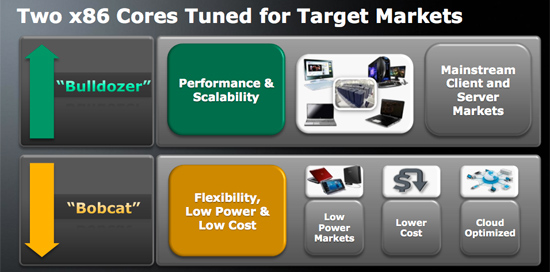
Generally a single microprocessor architecture can cover an order of magnitude of power envelopes. You can take an architecture from 10W - 100W using clock speed, voltage scaling and disabling features (e.g. cutting cache sizes). You can’t efficiently take a 100W architecture and scale it down to 1W. Intel realized this with Atom, and what resulted was a new architecture designed to span the 0.5W - 5W range. Given the constraints of the process (Atom was built at 45nm) and a desire to keep die size down to a minimum (and thus maximize profits), Intel went with a dual-issue in-order architecture reminiscent of the old Pentium - but with a modern twist.
AMD came to the same realization. For it to compete in these value markets, AMD couldn’t rely on its existing Phenom II derived architectures. The Phenom II and its relatives currently span a range of TDPs from 9W to 140W, and at the lower end of that spectrum we’re talking about some very low clock speeds and performance targets. Getting down to 1W was out of the question without a separate design.
What AMD came up with was a core called Bobcat, initially targeted for netbooks, notebooks, nettops and entry level desktops. Architecturally Bobcat is a significant step ahead of Atom: while still dual-issue, it features an out-of-order execution engine making it the Pentium Pro to Atom’s Pentium.
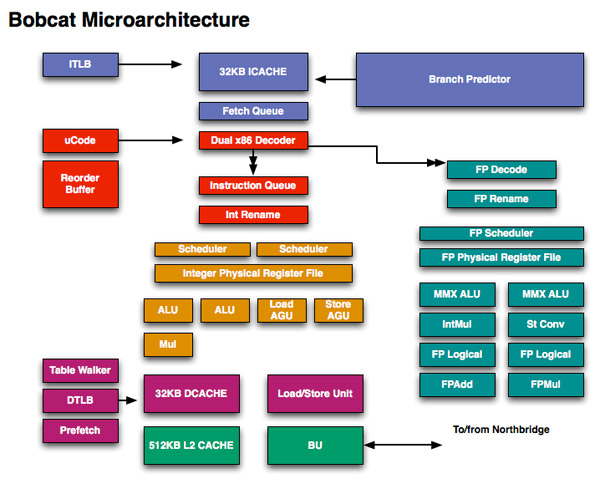
It isn’t just CPU architecture that AMD surpassed Atom with, the first incarnation of Bobcat is an integrated SoC with on-die DirectX 11 GPU. AMD calls this combination a Fusion APU (Accelerated Processing Unit) as it places both a CPU and GPU on a single die. The possible CPU/GPU combinations for Bobcat based APUs are listed in the table below:
| AMD Brazos Lineup | ||||||||
| APU Model | Number of Bobcat Cores | CPU Clock Speed | GPU | Number of GPU Cores | GPU Clock Speed | TDP | ||
| AMD E-350 | 2 | 1.6GHz | Radeon HD 6310 | 80 | 500MHz | 18W | ||
| AMD E-240 | 1 | 1.5GHz | Radeon HD 6310 | 80 | 500MHz | 18W | ||
| AMD C-50 | 2 | 1.0GHz | Radeon HD 6250 | 80 | 280MHz | 9W | ||
| AMD C-30 | 1 | 1.2GHz | Radeon HD 6250 | 80 | 280MHz | 9W | ||
AMD avoided branding its first APUs, they’re simply the AMD E-series and C-series Fusion APUs. The emphasis isn’t on the CPU or the GPU in this case, just the company name and a model number.
| CPU Specification Comparison | ||||||||
| CPU | Manufacturing Process | Cores | Transistor Count | Die Size | ||||
| AMD Zacate | 40nm | 2 | ? | 75 mm2 | ||||
| AMD Thuban 6C | 45nm | 6 | 904M | 346mm2 | ||||
| AMD Deneb 4C | 45nm | 4 | 758M | 258mm2 | ||||
| Intel Gulftown 6C | 32nm | 6 | 1.17B | 240mm2 | ||||
| Intel Nehalem/Bloomfield 4C | 45nm | 4 | 731M | 263mm2 | ||||
| Intel Sandy Bridge 4C | 32nm | 4 | 995M | 216mm2 | ||||
| Intel Lynnfield 4C | 45nm | 4 | 774M | 296mm2 | ||||
| Intel Clarkdale 2C | 32nm | 2 | 384M | 81mm2 | ||||
| Intel Sandy Bridge 2C (GT1) | 32nm | 2 | 504M | 131mm2 | ||||
| Intel Sandy Bridge 2C (GT2) | 32nm | 2 | 624M | 149mm2 | ||||
These APUs do need the aid of an additional chip - the Hudson Fusion Controller Hub (FCH). The FCH adds support for things like SATA, USB, Ethernet and Audio.The Hudson FCH is very tiny measuring approximately 4mm x 7mm for a total die size of around 28mm2.
The combination of these Bobcat based APUs and the FCH is called the Brazos platform.
Late last year AMD invited me to spend several hours with a Brazos system at its brand new campus in Austin, TX. While the preview gave us some insight into what we could expect from Brazos, I didn’t have enough time to really dive in as much as I would’ve liked to.
Earlier this month, AMD officially launched Brazos with hardware expected sometime this quarter. For the past couple of weeks I’ve been testing a Brazos mini-ITX motherboard from MSI and today, it’s time to break the silence and share the results. They are quite good.


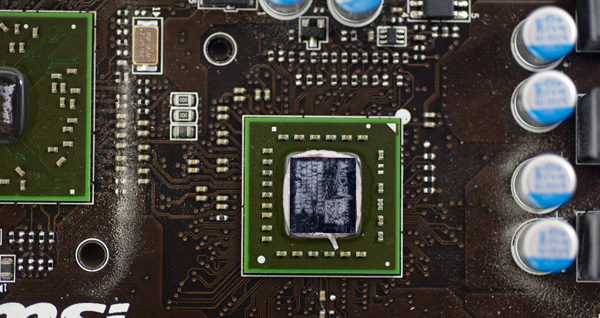
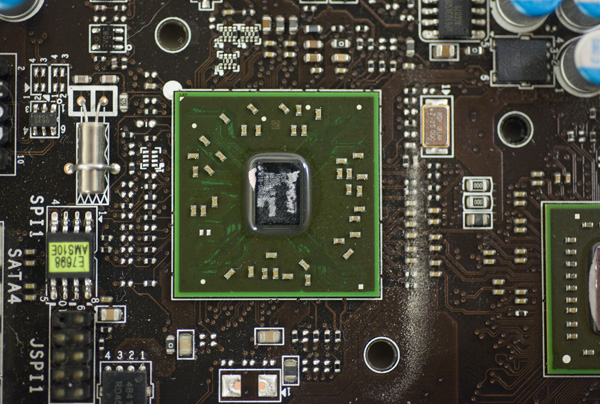
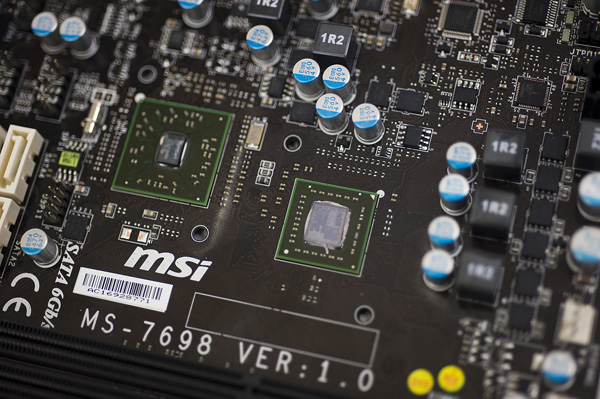
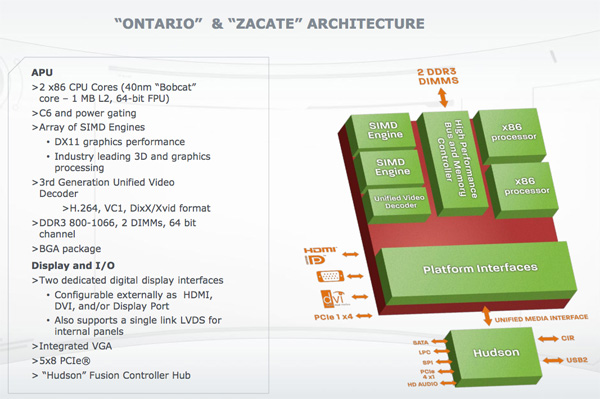








176 Comments
View All Comments
DanaG - Friday, January 28, 2011 - link
One thing I'm wondering: how does Brazos compare to Atom and ARM (such as QNAP TS-219P+) on power usage and network performance? From reviews of ARM devices, it looks like they hit a speed limit that may be caused by the SoC devices themselves.I do know that Realtek Gigabit Ethernet sucks, so it'd be worthwhile to benchmark with an Intel NIC and a Broadcom NIC, as well.
Aone - Friday, January 28, 2011 - link
I reckon Anand Lal Shimpi should know that neither Atom D510 nor Atom 330 supports EIST or Idle Power State. If he does compare the power consumtion he, at least, must mention it.And i'm not sure that Atom platform supports DDR3-1333 as Brazos. Usually Atom sticks with DDR2-667.
Unfortunately, mem config is absent from description of test configs.
DanNeely - Friday, January 28, 2011 - link
DDR3-800 based atoms launched a few months back; the performance difference vs their DDR2 siblings was negligible.krish123 - Friday, January 28, 2011 - link
Hi Anand,You are comparing the gaming performance of Core I5 2500K / higher clocked graphics with E350, but u should also show the power consumption/price difference on those parts. .. I feel ., kind of biased review, when you are trying to compare only the positive side of intel parts and not the negative side
I will wait for your review on Llano and bulldozer
Regards,
Kicha
7Enigma - Friday, January 28, 2011 - link
Did you even read the text or just look at the pretty graphs?The i5 is in there as a bracketing agent so that those of us with desktop systems can get a feel for the performance difference to these Atom/APU products. There was never a direct comparison drawn unless you ignore all the text and just stare at the pictures.
OneArmedScissorB - Friday, January 28, 2011 - link
Did you even read the pretty graphs? They were very nearly neck and neck in those comparisons. Why omit the most significant differentiation between the two?Sandy Bridge and Bobcat as HTPC platforms are more comparable than anything else. They are both at least "good enough" for general use, have similar IGP and video acceleration capabilities, and are both readily available in mini-ITX.
And yet, there's a 3.1 GHz Athlon II X2 with an 890GX board in the power results, likely full size ATX, in place of every single last one of the numerous mini-ITX platforms they could have just copied and pasted into the chart from past articles. Wtfbbq?!?
That was not just an oversight, but a very significant mistake that detracts from the usefulness of the entire article.
bjacobson - Saturday, January 29, 2011 - link
hm, that seems a bit of an overstatement. I don't really see how the 2500's are at all in the same market as this.code65536 - Friday, January 28, 2011 - link
I wonder, does Bobcat support hardware-assisted virtualization?silverblue - Friday, January 28, 2011 - link
I read that it does.macs - Friday, January 28, 2011 - link
Can someone test the power consumption of an i3 2100 on itx mobo? I suppose it will be quite close to brazos, at idle at least